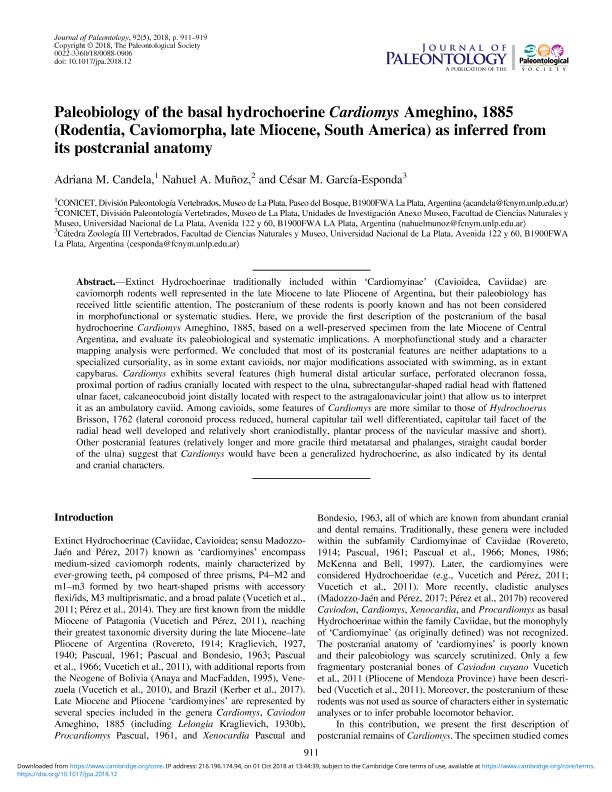Mostrar el registro sencillo del ítem
dc.contributor.author
Candela, Adriana Magdalena

dc.contributor.author
Muñoz, Nahuel Antu

dc.contributor.author
García Esponda, César M.
dc.date.available
2020-03-19T14:48:56Z
dc.date.issued
2018-09
dc.identifier.citation
Candela, Adriana Magdalena; Muñoz, Nahuel Antu; García Esponda, César M.; Paleobiology of the basal hydrochoerine Cardiomys Ameghino, 1885 (Rodentia, Caviomorpha, late Miocene, South America) as inferred from its postcranial anatomy; Paleontological Society; Journal of Paleontology; 92; 5; 9-2018; 911-919
dc.identifier.issn
0022-3360
dc.identifier.uri
http://hdl.handle.net/11336/100191
dc.description.abstract
Extinct Hydrochoerinae traditionally included within 'Cardiomyinae' (Cavioidea, Caviidae) are caviomorph rodents well represented in the late Miocene to late Pliocene of Argentina, but their paleobiology has received little scientific attention. The postcranium of these rodents is poorly known and has not been considered in morphofunctional or systematic studies. Here, we provide the first description of the postcranium of the basal hydrochoerine Cardiomys Ameghino, 1885, based on a well-preserved specimen from the late Miocene of Central Argentina, and evaluate its paleobiological and systematic implications. A morphofunctional study and a character mapping analysis were performed. We concluded that most of its postcranial features are neither adaptations to a specialized cursoriality, as in some extant cavioids, nor major modifications associated with swimming, as in extant capybaras. Cardiomys exhibits several features (high humeral distal articular surface, perforated olecranon fossa, proximal portion of radius cranially located with respect to the ulna, subrectangular-shaped radial head with flattened ulnar facet, calcaneocuboid joint distally located with respect to the astragalonavicular joint) that allow us to interpret it as an ambulatory caviid. Among cavioids, some features of Cardiomys are more similar to those of Hydrochoerus Brisson, 1762 (lateral coronoid process reduced, humeral capitular tail well differentiated, capitular tail facet of the radial head well developed and relatively short craniodistally, plantar process of the navicular massive and short). Other postcranial features (relatively longer and more gracile third metatarsal and phalanges, straight caudal border of the ulna) suggest that Cardiomys would have been a generalized hydrochoerine, as also indicated by its dental and cranial characters.
dc.format
application/pdf
dc.language.iso
eng
dc.publisher
Paleontological Society

dc.rights
info:eu-repo/semantics/openAccess
dc.rights.uri
https://creativecommons.org/licenses/by-nc-sa/2.5/ar/
dc.subject
PALEOBIOLOGY
dc.subject
CAVIOMORPHA
dc.subject
LATA MIOCENE
dc.subject
POSTCRANIUM
dc.subject.classification
Paleontología

dc.subject.classification
Ciencias de la Tierra y relacionadas con el Medio Ambiente

dc.subject.classification
CIENCIAS NATURALES Y EXACTAS

dc.title
Paleobiology of the basal hydrochoerine Cardiomys Ameghino, 1885 (Rodentia, Caviomorpha, late Miocene, South America) as inferred from its postcranial anatomy
dc.type
info:eu-repo/semantics/article
dc.type
info:ar-repo/semantics/artículo
dc.type
info:eu-repo/semantics/publishedVersion
dc.date.updated
2020-03-12T18:48:42Z
dc.identifier.eissn
0088-0906
dc.journal.volume
92
dc.journal.number
5
dc.journal.pagination
911-919
dc.journal.pais
Estados Unidos

dc.journal.ciudad
Lawrence
dc.description.fil
Fil: Candela, Adriana Magdalena. Universidad Nacional de La Plata. Facultad de Ciencias Naturales y Museo. División Paleontología Vertebrados; Argentina. Consejo Nacional de Investigaciones Científicas y Técnicas. Centro Científico Tecnológico Conicet - La Plata; Argentina
dc.description.fil
Fil: Muñoz, Nahuel Antu. Universidad Nacional de La Plata. Facultad de Ciencias Naturales y Museo. División Paleontología Vertebrados; Argentina. Consejo Nacional de Investigaciones Científicas y Técnicas. Centro Científico Tecnológico Conicet - La Plata; Argentina
dc.description.fil
Fil: García Esponda, César M.. Universidad Nacional de La Plata. Facultad de Ciencias Naturales y Museo. División de Zoología Invertebrados; Argentina
dc.journal.title
Journal of Paleontology

dc.relation.alternativeid
info:eu-repo/semantics/altIdentifier/doi/http://dx.doi.org/10.1017/jpa.2018.12
dc.relation.alternativeid
info:eu-repo/semantics/altIdentifier/url/https://www.cambridge.org/core/journals/journal-of-paleontology/article/paleobiology-of-the-basal-hydrochoerine-cardiomys-ameghino-1885-rodentia-caviomorpha-late-miocene-south-america-as-inferred-from-its-postcranial-anatomy/E0C5625902541C9C1DA30E4843FAF138
Archivos asociados
